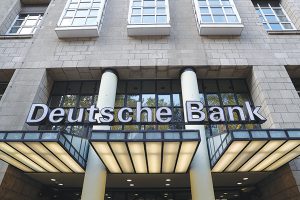When hiking in hills, like those around Frankfurt, you might crest a peak only to see another higher one beyond. This is where Deutsche Bank Chief Executive Officer Christian Sewing finds himself today.
The German lender quadrupled profit to 2.4 billion euros ($2.7 billion) in 2021 versus 2020, recording its best result in a decade — a praiseworthy achievement given the quagmire from which Sewing has dragged the bank since 2018. Back then, the bank was in a vicious spiral of stubborn costs and falling revenue as he noted himself. He now believes the bank has entered a virtuous one where investments in technology and people will drive revenue up and costs down. But the targets he set for 2022 look ambitious, and the climb from here remains steep.
The key number is Deutsche Bank’s ratio of costs to revenue: It had 85 cents of costs for every euro of revenue in 2021, and Sewing aims to get that to 70 cents this year. For comparison, at JPMorgan Chase & Co this was 59 cents per dollar of revenue in 2021.
This cost-to-income ratio has already fallen sharply: It was equivalent to nearly 90 cents in 2020 and 108 cents in 2019 — by definition a loss-making year.
Most of this recovery results from the pandemic-era boom in investment banking and trading that also brought record revenue to US banks. With that trend slacking off, Chief Financial Officer James von Moltke expects a dip in the investment bank’s top line this year compared with the one last year.
At the same time, there could be further upward pressure on pay in the investment bank because of the competition for people that is affecting the whole industry and elsewhere in the bank due to inflation, which has reached almost 5% in the euro zone.
To meet the bank’s cost-ratio target, more than two-thirds of the change is expected to come from further cost cuts and the rest mainly from revenue gains. That means it has to reduce costs by more than 2 billion euros and boost revenue by about 1 billion euros.
Investments in technology to move more operations to the cloud, for example, will need to provide much of the rest. This will be a grind that Sewing might give more detail about during an investor day planned for March.
On the revenue side, it will have to make up for the expected investment-banking dip. Deutsche Bank’s best business is trading bonds and currencies, which could fall from the past two years of unusually high activity.
It is doing better in investment-banking fees for advising on deals and fund raising. These were up 23% for the full year, in line with Bank of America but behind other big US rivals.
The corporate and retail banks could both contribute some growth in fees on top of an expected 150 million-euro gain in income from rising euro-zone interest rates.
The signs are improving for Deutsche Bank, but Sewing still has a long way to go to hit his targets. These final yards will be hard.
—Bloomberg
The asset-management business lifted revenue by 21% in 2021 and might see further growth — although markets have started the year on a rocky footing to say the least. Also, Deutsche Bank’s DWS subsidiary has some distractions to overcome: Regulators are still looking at claims of green-washing against it, for example.
Deutsche Bank’s stock, which is up nearly 40% over the past year, jumped on the results, though it still trades at nearly a 60% discount to forecast book value, one of the weakest valuations in Europe.
The signs are improving for Deutsche Bank, but Sewing still has a long way to go to hit his targets. These final yards will be hard.
—Bloomberg
 The Gulf Time Newspaper One of the finest business newspapers in the UAE brought to you by our professional writers and editors.
The Gulf Time Newspaper One of the finest business newspapers in the UAE brought to you by our professional writers and editors.
